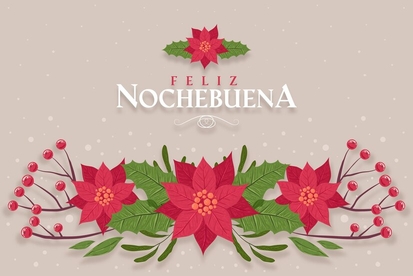What to Know About Nochebuena Around the World
Nochebuena, a Latinx and Filipinx Christmas Eve celebration, varies among regions but comes down to one essential shared element: the significance of family bonding and cultural appreciation.
 (Freepik)
(Freepik)
As the fall breeze transitions into a winter chill, Latinx and Filipinx families can be found deep cleaning their homes, rearranging their furniture, and grocery shopping for the feast that is Nochebuena. The holiday, which translates to “good night,” is a tradition celebrated by Latinx and Filipinx communities with big family gatherings, gift exchanges, dancing, and even games.
As a family bonding experience, Nochebuena involves a great deal of preparation when it comes to food, music, and the logistics of trying to comfortably fit a dozen or more people inside one home. For first-generation Latinx and Filipinx family members organizing this year’s Nochebuena, there are several traditions and stories surrounding the holiday that can make hosting a bit more peaceful.
Celebrated on Christmas Eve, Nochebuena is a celebration in which families gather for a late dinner party that typically lasts through the afternoon and into the early hours of the morning. It is traditionally centered around bonding and food though the cuisine varies between regions and cultures.
Cubans, for example, are known to create large plates of congri, Cuban rice and black beans; yuca con mojo, boiled and marinated yuca root with a citrusy garlic oil sauce; and lechon asado, mojo-marinated pork shoulder. Oftentimes, any leftover yuca would be made into yuca fries for Christmas Day, which is occasionally referred to as “leftover day” for these communities that celebrate the day prior.
In the past, Nochebuena was held later in the afternoon with dinner beginning around 8 to 10 p.m. to make time for La Misa de Gallo, which translates to “the Rooster’s Mass” and refers to Catholic mass gatherings intended to celebrate health, family, and the birth of Jesus Christ.
The holiday traces back to the spread of Catholicism and Spanish colonialism in the Philippines and Latin America with religious traditions like Las Posadas, which are mini-processions of adults and children reenacting the story of Mary and Joseph. That said, although Nochebuena started as a religious holiday, it has since evolved into a time for familial love and gift exchanging.
Soledad Aguilar-Colón, an Education and Outreach Coordinator for IndyKids, a multiplatform current events and social justice news source for adolescents, describes Nochebuena as a time for reconnecting with your family and your culture.
“American Christmas is so centered around waking up in the morning and having that gift exchange. Nochebuena is more about family. You celebrate your food, your family, your culture. You see people you haven’t seen in months. You make the coquito; you teach the children the different recipes. It’s a moment of connection.”
As a first-generation Puerto Rican-Peruvian, Aguilar-Colón notes the traditions her family partakes in that make the holiday feel homey and essential. Whether that be the interminable games of Dominoes or bingo, dancing to salsa music, or the hours of cooking Puerto Rican holiday dishes like pernil, Puerto Rican roasted pork shoulder; pasteles, meat-filled dough wrapped in green banana leaves; and arroz con gandules, Puerto Rican rice with pigeon peas.
“As someone who wasn’t born in Puerto Rico – I was born here – Nochebuena is my biggest connection to Puerto Rico. I get to have these family moments where I learn more about my culture, about the food, about the music, about salsa. It doesn’t feel American at all and that’s the importance of it for me.”
For many, Nochebuena is integral to the Latinx and Filipinx experience because it decentralizes the American experience through cultural appreciation, self-love, and community gathering. Some Filipinx families, for example, celebrate by singing villancicos – religious holiday carols – and indulging in Pinoy spaghetti, a Filipinx version of Italian spaghetti with sweet tomato sauce and smoked sausages; bibingka, a classic Filipinx rice cake; and hamonado, pineapple-infused chicken or pork.
Although prepping for the large dinner takes hours to make and weeks to prepare, the month of December is often swept away by a constant deep clean. While it is still celebrated in a family home, the event is more formal and fanciful — calling for hair blowouts, new party outfits, and traditional Christmas decor.
Nochebuena households can be filled to the brim with various forms of poinsettias. The flower is popular as a design on table runners, towels, placemats as well as in its original flower form. Native to Mexico, it’s commonly perceived as la flor de Nochebuena because it appears to be an even brighter red than normal around the holidays.
For decades, Mexican families have built a reputation for decorating with poinsettia and appear to have even more widely used traditions than most other ethnicities. Mexicans, for example, are known to celebrate with piñatas during the holidays. Many have argued that the falling of the piñata’s candy represents the falling of rewards from Heaven or the destroying of evil which traces back to the prevalence of Catholic community members in Latinx regions.
The acute differences between cultures in celebrating Nochebuena are reflective of what home and life look like within these regions — building a peephole into the beauty of cultural roots for long-distance families, immigrants, and first, second, and third generations. With its customs surrounding what to eat, what to listen to, and what to wear, Nochebuena inherently comes down to who you’re surrounded by and what you can give to the people you care so deeply for.
Rosie Marie Hendricks (they/them) is from New York City but is a Philly-based journalist who covers entertainment and culture. You can find them on Instagram @rosiehndrcks and on LinkedIn @rosiehendricks.
Edited by Nykeya Woods